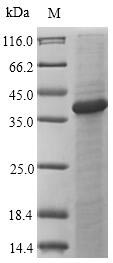The expression region of this recombinant Mouse Clec4a covers amino acids 70-238. The expected molecular weight for the Clec4a protein is calculated to be 39.6 kDa. This protein is generated in a e.coli-based system. The N-terminal 10xHis-SUMO tag and C-terminal Myc tag was fused into the coding gene segment of Clec4a, making it easier to detect and purify the Clec4a recombinant protein in the later stages of expression and purification.
Mouse C-type lectin domain family 4 member A (Clec4a) is a protein belonging to the C-type lectin domain family. Clec4a acts as a pattern recognition receptor (PRR) involved in the recognition of various pathogens, particularly fungi. It contains a C-type lectin domain that binds to carbohydrates on the surface of pathogens, initiating immune responses. Clec4a is primarily expressed in immune cells, such as dendritic cells and macrophages. Upon ligand binding, Clec4a activates signaling pathways that contribute to the immune response against invading microorganisms. The role of Clec4a in pathogen recognition makes it an essential component of the innate immune system, contributing to host defense against infections.






